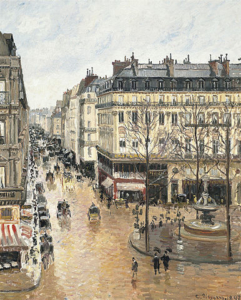
On April 30, 2019, after nearly 15 years of litigation, a federal judge in California has ruled that the Thyssen-Bornemisza Museum in Spain can keep a painting that the judge acknowledged was “wrongfully taken” by the Nazis from the Plaintiffs’ great-grandmother, Lilly Cassirer Neubauer. The 1897 painting, Rue St. Honoré, après-midi, effet de pluie – one of fifteen works painted by Camille Pissarro of the view from his Paris hotel room in 1897-98 – has been valued at $30 million.The court found that Lilly Neubauer was forced to transfer the painting to a Nazi art appraiser in 1939 to obtain exit visas for herself and her husband. In exchange, she was paid an amount well below the work’s value, with the funds being put into a blocked account she could not access. The judge also found that Baron Hans Heinrich Thyssen-Bornemisza – who purchased the painting from a New York City gallery in 1976 – did not acquire the painting in good faith under Swiss law, and thus did not receive and could not pass good title to the Thyssen-Bornemisza.
Nevertheless, the court found that the museum subsequently became the lawful owner of the work under Spain’s law of acquisitive prescription, similar to adverse possession in the United States; if a party’s good faith possession of property is uninterrupted for three years, or is uninterrupted for six years without the condition of good faith, the possessor acquires title. The court then ruled that a different provision of the Spanish Civil Code, which would have extended the time period further than six years if the museum was an “accessory” under Spanish law, did not apply because the museum did not have “actual knowledge” that the painting was stolen. The judge acknowledged that if Spanish law did not govern, the outcome would be different. The theft of the painting is not disputed, and under California law, a thief cannot pass title – even to a good faith purchaser. Thus, the outcome turned entirely on the decision to apply foreign law — in this case Spanish law — which has rarely occurred in Holocaust-era claims.
Hence, a Nazi theft and a purchase that was not made in good faith under Swiss law lead to title passing under Spanish law due to lack of actual knowledge that the painting was stolen – despite the suspicious circumstances and the Baron’s failure to exercise due diligence. In another anomaly, the judge faulted the Thyssen-Bornemisza for failing to follow international ethical guidelines for museums concerning the return of Nazi looted art to the theft victims or their heirs, as enunciated in the Washington Principles and the Terezin Declaration, but concluded he must follow Spanish law, rather than international ethical/moral principles.
The decision is available here: https://cdn2.hubspot.net/hubfs/878449/document(1)-1.pdf.